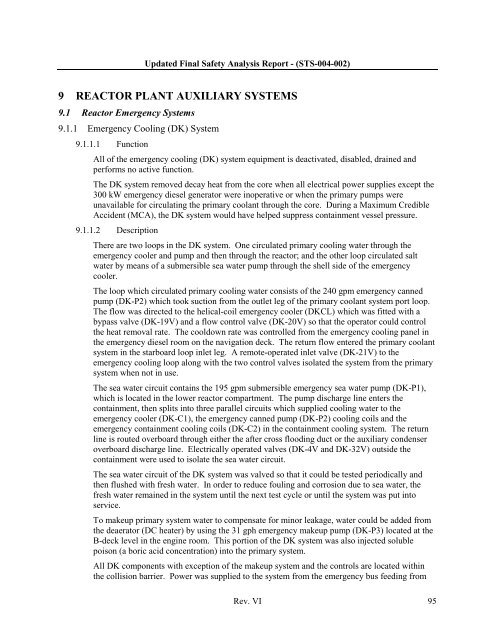10 CFR 50.71(e) - Maritime Administration - U.S. Department of ...
10 CFR 50.71(e) - Maritime Administration - U.S. Department of ...
10 CFR 50.71(e) - Maritime Administration - U.S. Department of ...
Create successful ePaper yourself
Turn your PDF publications into a flip-book with our unique Google optimized e-Paper software.
Updated Final Safety Analysis Report - (STS-004-002)9 REACTOR PLANT AUXILIARY SYSTEMS9.1 Reactor Emergency Systems9.1.1 Emergency Cooling (DK) System9.1.1.1 FunctionAll <strong>of</strong> the emergency cooling (DK) system equipment is deactivated, disabled, drained andperforms no active function.The DK system removed decay heat from the core when all electrical power supplies except the300 kW emergency diesel generator were inoperative or when the primary pumps wereunavailable for circulating the primary coolant through the core. During a Maximum CredibleAccident (MCA), the DK system would have helped suppress containment vessel pressure.9.1.1.2 DescriptionThere are two loops in the DK system. One circulated primary cooling water through theemergency cooler and pump and then through the reactor; and the other loop circulated saltwater by means <strong>of</strong> a submersible sea water pump through the shell side <strong>of</strong> the emergencycooler.The loop which circulated primary cooling water consists <strong>of</strong> the 240 gpm emergency cannedpump (DK-P2) which took suction from the outlet leg <strong>of</strong> the primary coolant system port loop.The flow was directed to the helical-coil emergency cooler (DKCL) which was fitted with abypass valve (DK-19V) and a flow control valve (DK-20V) so that the operator could controlthe heat removal rate. The cooldown rate was controlled from the emergency cooling panel inthe emergency diesel room on the navigation deck. The return flow entered the primary coolantsystem in the starboard loop inlet leg. A remote-operated inlet valve (DK-21V) to theemergency cooling loop along with the two control valves isolated the system from the primarysystem when not in use.The sea water circuit contains the 195 gpm submersible emergency sea water pump (DK-P1),which is located in the lower reactor compartment. The pump discharge line enters thecontainment, then splits into three parallel circuits which supplied cooling water to theemergency cooler (DK-C1), the emergency canned pump (DK-P2) cooling coils and theemergency containment cooling coils (DK-C2) in the containment cooling system. The returnline is routed overboard through either the after cross flooding duct or the auxiliary condenseroverboard discharge line. Electrically operated valves (DK-4V and DK-32V) outside thecontainment were used to isolate the sea water circuit.The sea water circuit <strong>of</strong> the DK system was valved so that it could be tested periodically andthen flushed with fresh water. In order to reduce fouling and corrosion due to sea water, thefresh water remained in the system until the next test cycle or until the system was put intoservice.To makeup primary system water to compensate for minor leakage, water could be added fromthe deaerator (DC heater) by using the 31 gph emergency makeup pump (DK-P3) located at theB-deck level in the engine room. This portion <strong>of</strong> the DK system was also injected solublepoison (a boric acid concentration) into the primary system.All DK components with exception <strong>of</strong> the makeup system and the controls are located withinthe collision barrier. Power was supplied to the system from the emergency bus feeding fromRev. VI 95
















